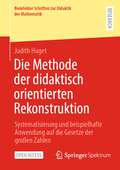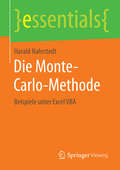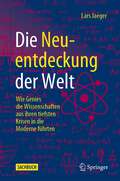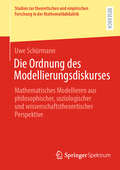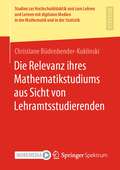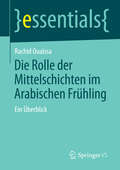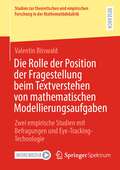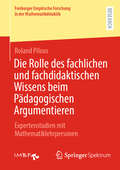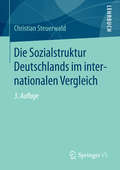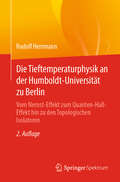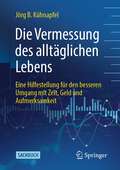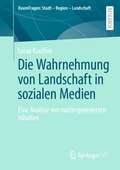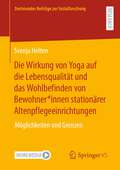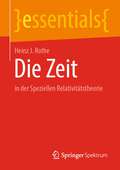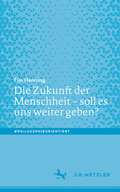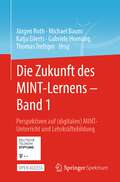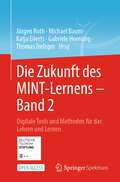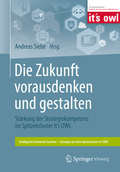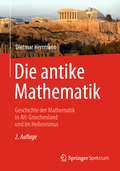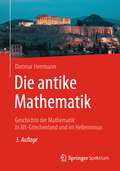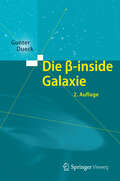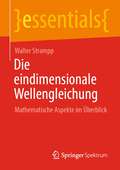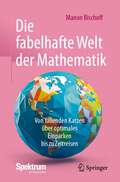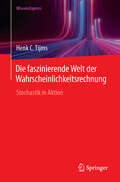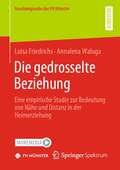- Table View
- List View
Die Methode der didaktisch orientierten Rekonstruktion: Systematisierung und beispielhafte Anwendung auf die Gesetze der großen Zahlen (Bielefelder Schriften zur Didaktik der Mathematik #11)
by Judith HugetIn diesem Open-Access-Buch systematisiert Judith Huget in einer theoretischen Herangehensweise eine stoffdidaktische Methode - die didaktisch orientierte Rekonstruktion - zur Ausdifferenzierung von Wissenselementen von Lehrkräften. Anhand dieser Methode werden anschließend exemplarisch Fachwissenselemente für Lehrkräfte am Beispiel des empirischen, schwachen und starken Gesetzes der großen Zahlen identifiziert und strukturiert.
Die Monte-Carlo-Methode: Beispiele unter Excel VBA (essentials)
by Harald NahrstedtHarald Nahrstedt zeigt hier den pragmatisch technischen und weniger den wissenschaftlichen Ansatz, wie Excel mit seinen Programmiermöglichkeiten sich immer mehr zu einem universellen Arbeitsmittel entwickelt. So ist die Simulation mit Hilfe von Pseudozufallszahlen ein schneller und preiswerter Weg zu fachlichen Aussagen. Den Rahmen dieser Abhandlung bildet der geschichtliche Hintergrund.
Die Neuentdeckung der Welt: Wie Genies die Wissenschaften aus ihren tiefsten Krisen in die Moderne führten
by Lars JaegerBahnbrechende Erkenntnisse und tiefe Krisen, revolutionäre Entdeckungen und Widerlegung von bis dato unverrückbaren Glaubenssätzen – die Jahre zwischen 1870 und 1950 sind geprägt durch wissenschaftliche Errungenschaften zahlreicher Genies und junger Vordenker. Erkenntnisse, die das Verständnis von der Welt, von Raum, Zeit und Unendlichkeit, von Leben und Menschheit, Logik und Berechenbarkeit nahezu über Nacht aushebelten. Einige der Akteure, wie Georg Cantor oder Ludwig Boltzmann, aber auch Albert Einstein und Kurt Gödel sind darüber fast verrückt geworden.Lars Jaeger illustriert, wie eng in diesen 80 Jahren Genialität, Intuition und Krise beieinanderlagen, und wie ein Inferno an geistigen Revolutionen unser heutiges Leben und Denken prägt. Dies geht weit über die Physik mit ihrer Quantentheorie und Relativitätstheorie hinaus, deren Revolutionen am häufigsten dargestellt werden, sondern betrifft auch die Biologie (Evolutionstheorie und Genetik), die Chemie (Molekularstrukturen), die Psychologie (das Unbewusste) und andere wissenschaftliche Disziplinen. Spannende Anekdoten aus dem Leben bekannter Wissenschaftler illustrieren, wie sich ein neues Denken aus einer Kraft der intuitiven Genialität zuerst in den Köpfen der Genies dieser Zeit implementierte, und dann die Grundlage des modernen wissenschaftlichen Denkens und technologischen Fortschritt - und damit wohl auch die Entwicklung der Menschheit insgesamt - bildete. Informativ, unterhaltsam und spannend wie ein Wissenschaftskrimi erzählt Lars Jaeger, wie eng die Entstehung der modernen Wissenschaften von Physik und Mathematik über die Chemie bis hin zur Biologie und Psychologie mit existenziellen Krisen ihrer Entdecker und Entwickler verknüpft ist.
Die Ordnung des Modellierungsdiskurses: Mathematisches Modellieren aus philosophischer, soziologischer und wissenschaftstheoretischer Perspektive (Studien zur theoretischen und empirischen Forschung in der Mathematikdidaktik)
by Uwe SchürmannIn dieser Literaturarbeit werden zentrale Topoi didaktischer Forschung zu mathematischen Modellierungen diskutiert und problematisiert. Dazu wird erstens, motiviert durch ein ontisches Erkenntnisinteresse, auf das Weltverhältnis von Mathematik überhaupt und die Rolle von mathematischen Modellen in gesellschaftlichen Zusammenhängen im Besonderen geblickt. Zweitens wird ein epistemologisches Erkenntnisinteresse auf die Frage gerichtet, auf welche Weise die Verbindung von Mathematik und Realität im Sinne eines Übersetzungsprozesses gedacht werden kann. Drittens wird, geleitet von einem konzeptuellen Erkenntnisinteresse, der Versuch unternommen, einen Beitrag zur Theoriebildung zur Erforschung von Modellierungsprozessen zu leisten. Um den unterschiedlichen Erkenntnisinteressen gerecht zu werden, rekurriert dieses Buch auf zwei verschiedene Forschungsparadigmen: Zur Beantwortung von Fragen, die sich aus dem ontischen Erkenntnisinteresse ergeben, wird auf poststrukturelle Denkmuster zurückgegriffen, wie sie in der soziologisch orientierten Mathematikdidaktik geläufig sind. Zur Beantwortung von Fragen, die sich aus dem epistemologischen und dem konzeptuellen Erkenntnisinteresse ergeben, wird auf Denkmuster aus der Wissenschaftstheorie in der Tradition analytischer Philosophie zurückgegriffen.
Die Relevanz ihres Mathematikstudiums aus Sicht von Lehramtsstudierenden (Studien zur Hochschuldidaktik und zum Lehren und Lernen mit digitalen Medien in der Mathematik und in der Statistik)
by Christiane Büdenbender-KuklinskiViele Mathematiklehramtsstudierende sind bisher unzufrieden mit dem Studium und einige kritisieren explizit eine fehlende Relevanz. Es stellt sich die Frage, welche Mechanismen und Zusammenhänge hinter der Kritik an fehlender Relevanz stehen. In der vorliegenden Arbeit wird ein Modell entwickelt, das der Beschreibung von Relevanzzuschreibungen von Mathematiklehramtsstudierenden dient und auf dessen Grundlage das entsprechend konzeptualisierte Konstrukt der Relevanzzuschreibungen quantitativ-empirisch beforscht wird. Aus einer Darstellung des lernkontextübergreifenden Forschungsstandes zu Relevanz- und Wertkonstrukten und deren Zusammenhängen zu affektiven und leistungsbezogenen Merkmalen sowie Lernaktivitäten heraus, werden Forschungsfragen zur explorativen Beforschung der Mechanismen und Zusammenhänge des Konstrukts der Relevanzzuschreibungen entwickelt. Die Ergebnisse der Längsschnittuntersuchung deuten an, dass das Konstrukt der Relevanzzuschreibungen besonders stark mit affektiven Merkmalen der Studierenden zusammenhängt, und sie bieten Anhaltspunkte für die Konzeption von Maßnahmen, die Relevanzzuschreibungen zum Mathematikstudium von Lehramtsstudierenden unterstützen könnten.
Die Rolle der Mittelschichten im Arabischen Frühling: Ein Überblick (essentials)
by Rachid OuaissaDer Beitrag diskutiert die Rolle der Mittelschichten in den Transformationsprozessen der arabischen Welt in der jüngeren Geschichte. Rachid Ouaissa vertritt die These, dass die arabischen Mittelschichten zwar die Hauptträger von Protesten sind, jedoch keine strukturellen Druckmittel besitzen, um Demokratisierung durchzusetzen. Denn im Gegensatz zu den profitorientierten europäischen Mittelschichten sind die arabischen Mittelschichten klientelisiert und rentenorientiert.
Die Rolle der Position der Fragestellung beim Textverstehen von mathematischen Modellierungsaufgaben: Zwei empirische Studien mit Befragungen und Eye-Tracking-Technologie (Studien zur theoretischen und empirischen Forschung in der Mathematikdidaktik)
by Valentin BöswaldDas Verstehen der Realsituation in Modellierungsaufgaben ist eine notwendige Bedingung für einen korrekten Lösungsprozess. Eine Determinante des Textverstehens ist das Leseziel. Durch dieses kann die Aufmerksamkeit beim Lesen und Verstehen eines Textes auf lesezielrelevante Informationen gerichtet werden. Das Leseziel sollte sich konkretisieren lassen, indem die zu einer Modellierungsaufgabe zugehörige Fragestellung dem Aufgabentext vorangestellt wird. Frühere Studien zeigen, dass die Spezifizierung des Leseziels über die Voranstellung von Fragestellungen vor den Text positive Effekte auf das Leseverhalten, das Textverstehen und die Effizienz dabei induzieren kann. In zwei Studien mit Lernenden der gymnasialen Oberstufe und aus Erweiterungskursen der Realschule wurde überprüft, inwiefern diese Ergebnisse sich auf Modellierungsaufgaben übertragen lassen. In Studie 1 (N = 192) wurde der Einfluss der Position der Fragestellung auf die Lese- und Bearbeitungsdauer, das Textverstehen und das Mathematisieren bei Modellierungsaufgaben untersucht. In Studie 2 (N = 75) wurde zudem überprüft, inwiefern die Position der Fragestellung das Leseverhalten und die Aufmerksamkeitsallokation auf (ir-)relevante Informationen in den verschiedenen Phasen des Leseprozesses beeinflusst.
Die Rolle des fachlichen und fachdidaktischen Wissens beim Pädagogischen Argumentieren: Expertenstudien mit Mathematiklehrpersonen (Freiburger Empirische Forschung in der Mathematikdidaktik)
by Roland PilousDie Forschung zum Pädagogischen Argumentieren untersucht, wie Lehrpersonen ihr Wissen nutzen, um zu produktiven Unterrichtshandlungen zu kommen. Es wird insbesondere angenommen, dass fachliches und fachdidaktisches Wissen relevant ist, um Vor- und Nachteile alternativer Unterrichtshandlungen in typischen Anforderungssituationen zu analysieren und so zu professionellen Entscheidungen zu gelangen. In der vorliegenden Arbeit wird die Nutzung des mathematikbezogenen fachlichen und fachdidaktischen Wissens von angehenden Mathematiklehrpersonen (Novizen) und qualifizierten Mathematiklehrpersonen (Experten) verglichen. Die dazu durchgeführten Studien liefern empirische Belege dafür, dass sich Expertise von Mathematiklehrpersonen auch in der Fähigkeit zeigt, verschiedene fachliche und fachdidaktische Argumente flexibel auf potentielle Unterrichtshandlungen beziehen zu können. Das fachliche und fachdidaktische Wissen entfaltet demnach seine Wirkung für die Unterrichtspraxis insbesondere dann, wenn dieses in Form von fachlichen und fachdidaktischen Argumenten integrativ auf Unterrichtshandlungen bezogen werden kann.
Die Sozialstruktur Deutschlands im internationalen Vergleich
by Christian SteuerwaldNationale Sozialstrukturanalysen machen im Zeitalter der Globalisierung immer weniger Sinn. Daher wird in diesem Buch die Entwicklung der deutschen Sozialstruktur mit der anderer Länder verglichen. Im Mittelpunkt stehen dabei europäische Länder, in vieler Hinsicht werden aber auch außereuropäische, moderne und sich entwickelnde Länder einbezogen. Im Einzelnen werden Strukturen der Bevölkerung, der Haushalte und Familien, der Bildung und der Erwerbstätigkeit, der sozialen Ungleichheit, der sozialen Sicherung und der Lebensweisen einander gegenüber gestellt. Vergleichsmaßstäbe werden aus Modernisierungstheorien gewonnen.
Die Tieftemperaturphysik an der Humboldt-Universität zu Berlin: Vom Nernst-Effekt zum Quanten-Hall-Effekt hin zu den Topologischen Isolatoren
by Rudolf HerrmannDieses Werk betrachtet die Entwicklungen der Physik der Wärme, speziell der Tieftemperaturphysik, an der Humboldt-Universität zu Berlin. Dabei bettet der Autor die physikalischen Zusammenhänge und Erkenntnisse in den zeitgeschichtlichen Hintergrund und die politischen Gegebenheiten ein. Beginnend in der ersten Hälfte des 20. Jahrhunderts werden die durch das Kaiserreich geförderten Entwicklungen der physikalischen und chemischen Forschung in Berlin dargestellt, in deren Rahmen Walter Nernst durch Messungen der spezifischen Wärmekapazität von Metallen bei tiefen Temperaturen die Phononen Theorie von Einstein und damit die Quantentheorie experimentell bestätigten konnte. Es wird beschrieben, wie in der zweiten Hälfte des Jahrhunderts nach dem Ende des II. Weltkrieges, 1945, die Humboldt-Universität versuchte, wieder den Anschluss für diese Wissenschaftsgebiete zu finden. Die Erfahrungen, die die Teilung Deutschlands und das Leben und die Forschung in der DDR mit sich gebracht haben, sowie die Fortschritte bei der Erzeugung von tiefen Temperaturen, und ihr Einsatz bei der Erforschung der Struktur fester Körper, für Detektoren von Radioteleskopen und die Erzeugung von Bose-Einstein-Kondensaten werden anschließend beleuchtet. Neben der Gesamtentwicklung des Wissenschaftsgebiets legt das Werk dabei einen besonderen Fokus auf die Erforschung der Struktur fester Körper. Dazu gehören auch fortgeschrittene Themen wie der Quanten-Hall-Effekt und Supraleitung. Da sich die Festkörper Tellur, Wismut und die Wismut-Antimon-Legierungen, deren elektronische Eigenschaften an der Humboldt-Universität bei tiefen Temperaturen gründlich untersucht worden waren, als topologische Isolatoren herausgestellt haben, wurden ihr toplogisches Verhalten in der vorliegenden, neuen Auflage den Arbeiten bei tiefen Temperaturen und dem Nernstschen Wärmesatz zur Seite gestellt. Aus der Analyse geht hervor, dass eine Reihe von Ergebnissen der Untersuchungen der elektronischen Struktur dieser Festkörper in den 1960ger und 1970ger Jahre schon topologisches Verhalten gezeigt haben. Wobei das innere Magnetfeld im Wismut, das mit dem Gantmacher-Effekt 1974 entdeckt wurde, mit großer Wahrscheinlichkeit auf der Topologie der Elektronenstruktur von Wismut beruht.
Die Vermessung des alltäglichen Lebens: Eine Hilfestellung für den besseren Umgang mit Zeit, Geld und Aufmerksamkeit
by Jörg B KühnapfelDieses Buch seziert die Art und Weise, wie wir unseren Alltag ausmessen, abwägen und bewerten, um die eigene, ganz persönliche Welt klarer zu sehen und die wertvollen Ressourcen Zeit, Geld und Aufmerksamkeit für ein erfüllteres Lebens einzusetzen. Dafür stehen sechs Methoden zur Verfügung: Messen, Zählen und Wiegen sowie Schätzen, Vergleichen und Abhaken von Checklisten. Dabei fällt die Auswahl der Bewertungskriterien ebenso subjektiv aus wie die eigenen Bewertungen.Dieses Buch stellt diese Messmethoden an alltäglichen Beispielen vor und erläutert die geeigneten Methoden, um zu guten Alltags- und Lebensentscheidungen zu gelangen. Wahrnehmungsverzerrungen und (Selbst-) Manipulationen werden ebenso berücksichtigt wie die Frage, wie sich Unsicherheiten integrieren lassen.
Die Wahrnehmung von Landschaft in sozialen Medien: Eine Analyse von nutzergenerierten Inhalten (RaumFragen: Stadt – Region – Landschaft)
by Lucas KaußenObwohl die Nutzung von sozialen Medien in der Landschaftsplanungspraxis noch recht neu ist, gewinnen Social-Media-Daten und deren Nutzung im Rahmen der forschenden Landschaftsplanung zunehmend an Bedeutung. Es besteht die Erwartung, dass die in den sozialen Medien von Nutzern bereitgestellten Daten Informationen liefern, die bisher in aufwändigen Beteiligungsprozessen erhoben werden mussten. Ein großes Potenzial liegt insbesondere in der enormen Menge an verfügbaren Fotografien, geographischen Informationen und Textelementen wie Beschreibungen und Kommentaren, die im Rahmen einer landschaftsplanerischen Bewertung der Landschaft genutzt werden können. Ziel dieser Arbeit ist es daher, intersubjektive Aussagen über die Wahrnehmung der Landschaft in Bezug auf einen bestimmten Raum zu generieren. Qualitative Methoden werden zur Auswertung von Fotografien, textlichen und geografischen Daten aus sozialen Medien kombiniert, wodurch Erkenntnisse über die Wahrnehmung von Landschaften erlangt und für landschaftsplanerische Analysen aufbereitet werden können.
Die Wirkung von Yoga auf die Lebensqualität und das Wohlbefinden von Bewohner*innen stationärer Altenpflegeeinrichtungen: Möglichkeiten und Grenzen (Dortmunder Beiträge zur Sozialforschung)
by Svenja HeltenIn diesem Buch rückt das „gute Leben“ im hohen Alter in den Fokus: So ist in den westlichen Industrienationen ein stetiger Anstieg der allgemeinen Lebenserwartung zu verzeichnen. Die gewonnene Lebenszeit geht jedoch nicht automatisch mit einem guten Gesundheitszustand einher: Gerade Hochaltrige sind häufig von einer oder mehreren chronischen Erkrankungen betroffen, die mit zahlreichen funktionellen Einschränkungen in ihrem Alltag verbunden sind und oftmals den Umzug in eine stationäre Einrichtung der Altenpflege bedingen. Die damit verbundenen Umstände bergen das Risiko, die Lebensqualität der Betroffenen zu verringern. Eine Fördermöglichkeit könnte in der Einführung von Yoga-Kursen bestehen, da empirische Untersuchungen mit verschiedenen Studienpopulationen die Schlussfolgerung nahelegen, dass sich eine regelmäßige Yoga-Praxis positiv auf verschiedene Parameter auswirkt, die mit den Konstrukten von Lebensqualität und Wohlbefinden assoziiert sind. Für die vorliegende Arbeit wurde daher ein Yoga-Kurskonzept entwickelt, das den Bedürfnissen von Bewohner*innen von stationären Altenpflegeeinrichtungen ohne Demenzerkrankungen gerecht zu werden anstrebt und in Form einer Pilotstudie in einer stationären Altenpflegeeinrichtung erprobt.
Die Zeit: in der Speziellen Relativitätstheorie (essentials)
by Heinz J. RotheEinsteins neue Deutung der Zeit ist der Kern seiner Speziellen Relativitätstheorie (SRT). In der SRT spielt die Zeit nicht mehr die Rolle eines reinen Parameters unabhängig vom Raum; dies führt zu Konsequenzen, die für uns sehr befremdlich sind. Alle ungewohnten Aussagen der SRT sind auf den von Einstein geprägten neuen Zeitbegriff zurückzuführen. Das Hauptanliegen dieses Buches ist es, dem Leser ein konzeptuell schwieriges Thema so weit wie möglich transparent zu vermitteln, wobei auf eine Diskussion der subtilen Aspekte besonderer Wert gelegt wird.
Die Zukunft der Menschheit – soll es uns weiter geben? (#philosophieorientiert)
by Tim HenningEin nahes Ende der Menschheit ist für die meisten von uns eine bedrohliche Vorstellung – z.B. als ein Aspekt dessen, was Pandemien und den Klimawandel so beängstigend macht. Aber ist es eigentlich wirklich wünschenswert, dass es weiter Menschen gibt? Worin würde der Schaden bestehen, wenn keine neuen Menschen mehr entstehen würden? Ist es vielleicht sogar umgekehrt ein Schaden, wenn weiter neue Menschen zur Existenz gebracht werden – für den Rest der Welt, vielleicht aber sogar für diese neuen Menschen selbst? Auch die Vorstellung von einem kontinuierlichen Wachstum der menschlichen Bevölkerung macht vielen von uns Angst. Wenn es also in Zukunft Menschen gibt – wie viele sollten es sein? Je mehr desto besser, auch auf Kosten der individuellen Lebensqualität? Oder sind neue Menschen nur solange willkommen, wie sich niemand einschränken muss? Der vorliegende Band führt in diese existenziellen Zukunftsfragen ein. Knapp, pointiert und ohne Jargon präsentiert er die frappierenden und inspirierenden Argumente, mit denen die aktuelle Philosophie unsere Zukunft durchdenkt.
Die Zukunft des MINT-Lernens – Band 1: Perspektiven auf (digitalen) MINT-Unterricht und Lehrkräftebildung
by Jürgen Roth Katja Eilerts Michael Baum Gabriele Hornung Thomas TrefzgerDieser Open-Access-Sammelband stellt Perspektiven auf digitalen MINT-Unterricht und die Lehrkräftebildung der Zukunft dar. Auf Grundlage aktueller Forschungsergebnisse beantwortet er aktuelle Fragestellungen, etwa: Welche Kompetenzen und welche Lerninhalte werden für die Herausforderungen von morgen benötigt und welchen Beitrag können die MINT-Fächer dazu leisten? Inwiefern kann die Digitalisierung bei einem Lernen für die Zukunft unterstützen bzw. ist sie notwendiger Bildungsinhalt für zukünftiges Handeln? Welche digitalen Technologien, digitalen Werkzeuge und digitalen Lernumgebungen können bei der Entwicklung von 21st Century Skills bei Lernenden beitragen? Wie müssen sie ausgestaltet sein, um beim Lernen und Problemlösen unterstützend zu wirken und die Lernenden zum kritischen Denken (Critical Thinking) anzuregen? Wie kann eine Diagnostik mit digitalen Methoden aussehen? Was folgt aus all dem für die MINT-Lehrkräftebildung? Der vorliegende erste Band ist Teil eines zweibändigen Sammelwerks; die beiden Bände sind weitgehend unabhängig voneinander lesbar und unterscheiden sich in ihrem inhaltlichen Fokus: Während Band 1 grundsätzliche Perspektiven beleuchtet, fokussiert Band 2 eher auf konkrete digitale Tools und Methoden für die Unterrichtspraxis. Die Beiträge wurden im Rahmen des Projekts „Die Zukunft des MINT-Lernens – Denkfabrik für Unterricht mit digitalen Technologien“, gefördert durch die Deutsche Telekom Stiftung, entwickelt. Sie decken verschiedene (assoziierte) Projekte des Entwicklungskonsortiums der beteiligten Hochschulstandorte ab und bieten zukunftsweisendes Wissen zum Thema.
Die Zukunft des MINT-Lernens – Band 2: Digitale Tools und Methoden für das Lehren und Lernen
by Jürgen Roth Katja Eilerts Michael Baum Gabriele Hornung Thomas TrefzgerDieser Open-Access-Sammelband stellt zukunftsweisende digitale Tools, Methoden und Konzepte für guten MINT-Unterricht vor: Er erläutert und diskutiert insbesondere Konzepte und Forschungsergebnisse zur lernförderlichen Gestaltung von digitalen Erweiterungen analoger Lehr- und Lernmethoden sowie von digitalen Lernumgebungen für zukünftige Anforderungen. Dabei geht er unter anderem auf das (digitale) Experimentieren, Videoanalyse, Augmented Reality und Gestaltungskriterien für Virtual-Reality-Lernumgebungen ein. Auf Grundlage aktueller Forschungsergebnisse beantwortet das Buch aktuelle Fragestellungen, etwa: Inwiefern kann die Digitalisierung bei einem MINT-Lernen für die Zukunft unterstützen? Welche digitalen Technologien, digitalen Werkzeuge und digitalen Lernumgebungen können bei der Entwicklung von 21st Century Skills bei Lernenden beitragen? Wie müssen sie ausgestaltet sein, um beim Lernen und Problemlösen unterstützend zu wirken und die Lernenden zum kritischen Denken (Critical Thinking) anzuregen? Der vorliegende zweite Band ist Teil eines zweibändigen Sammelwerks; die beiden Bände sind weitgehend unabhängig voneinander lesbar und unterscheiden sich in ihrem inhaltlichen Fokus: Während Band 1 grundsätzliche Perspektiven beleuchtet, fokussiert Band 2 eher auf konkrete digitale Tools und Methoden für die Unterrichtspraxis. Die Beiträge wurden im Rahmen des Projekts „Die Zukunft des MINT-Lernens – Denkfabrik für Unterricht mit digitalen Technologien“, gefördert durch die Deutsche Telekom Stiftung, entwickelt. Sie decken verschiedene (assoziierte) Projekte des Entwicklungskonsortiums der beteiligten Hochschulstandorte ab und bieten zukunftsweisendes Wissen zum Thema.
Die Zukunft vorausdenken und gestalten: Stärkung Der Strategiekompetenz Im Spitzencluster It's Owl (Intelligente Technische Systeme – Lösungen aus dem Spitzencluster it’s OWL)
by Andreas SiebeDas Buch beschreibt anschaulich die Ergebnisse der Nachhaltigkeitsmaßnahme „it’s owl – VorZug; Vorausschau – Die Zukunft vorausdenken und gestalten“ des Spitzencluster it’s owl – Intelligente technische Systeme Ostwestfalen-Lippe.Vorausschau und die effiziente Integration der Ergebnisse in die Planungsprozesse ist bereits heute ein erfolgsentscheidender Faktor. Unternehmen, die dies nicht nutzen, landen häufig mit den falschen Produkten zur falschen Zeit am Markt. Dies wird unterstrichen durch eine Studie von Cooper (2001), derzufolge 24% aller untersuchten fehlgeschlagenen Innovationen haupt-sächlich an „unzureichender Marktanalyse“, 16% an „Produkten, die nicht den Erwartungen entsprechen“ und 14% an „ungenügendem Marketingaufwand“ (zugleich den drei insgesamt auch am häufigsten genannten Ursachen) scheitern, wohingegen bei lediglich 6% „technische Probleme bei der Entwicklung“ als Hauptursache angegeben worden ist. Es gilt, die daraus resultierenden Fehlinvestitionen durch Vorausschau zu minimieren.Ziel des Vorhabens, war ein Instrumentarium, welches Inhalte, Methoden und IT-Werkzeuge für den Frühaufklärungsprozesses beinhaltet und den Cluster als Ganzes, aber insbesondere auch die Clusterunternehmen befähigt, wirkungsvoll und effizient Vorausschau zu betreiben und daraus die erforderlichen Schlüsse für die Entwicklung von Geschäfts-, Produkt- und Technologiestrategien zu ziehen. Neben den einzelnen Bausteinen der Betrachtung werden insbesondere auch die Erkenntnisse aus den Pilotprojekten ausgeführt.
Die antike Mathematik: Geschichte der Mathematik in Alt-Griechenland und im Hellenismus
by Dietmar HerrmannDer Band enthält eine umfassende und problemorientierte Darstellung der antiken griechischen Mathematik von Thales bis zu Proklos Diadochos. Exemplarisch wird ein Querschnitt durch die griechische Mathematik geboten, wobei auch solche Werke von Wissenschaftlern ausführlich gewürdigt werden, von denen keine deutsche Übersetzung vorliegt. Zahlreiche Abbildungen und die Einbeziehung des kulturellen, politischen und literarischen Umfelds liefern ein großartiges Spektrum der mathematischen Wissenschaftsgeschichte und eine wahre Fundgrube für diejenigen, die biographisches und zeitgeschichtliches Hintergrundwissen suchen oder Anregungen für Unterricht bzw. Vorlesung. Die Darstellung ist aktuell und realisiert Tendenzen neuerer Geschichtsschreibung. In der Neuauflage konnten die zentralen Kapitel über Platon, Aristoteles und Alexandria aktualisiert werden. Die Ausführungen zur griechischen Rechentechnik, mathematischen Geographie und Mathematik des Frühmittelalters wurden erweitert und zeigen neue Gesichtspunkte. Völlig neu hinzugekommen ist eine einzigartige, illustrierte Darstellung der Römischen Mathematik. Neu aufgenommen sind auch mehrere Farbabbildungen, die die Thematik des Buches gelungen veranschaulichen. Mit mehr als 280 Bildern stellt der vorliegende Band ein reich bebildertes Geschichtsbuch zur antiken Mathematik dar.
Die antike Mathematik: Geschichte der Mathematik in Alt-Griechenland und im Hellenismus
by Dietmar HerrmannDer Band enthält eine umfassende und problemorientierte Darstellung der antiken griechischen Mathematik von Thales bis zu Proklos Diadochos. Exemplarisch wird ein Querschnitt durch die griechische Mathematik geboten, wobei auch solche Werke von Wissenschaftlern ausführlich gewürdigt werden, von denen keine deutsche Übersetzung vorliegt. Zahlreiche Abbildungen und die Einbeziehung des kulturellen, politischen und literarischen Umfelds liefern ein großartiges Spektrum der mathematischen Wissenschaftsgeschichte und eine wahre Fundgrube für diejenigen, die biographisches und zeitgeschichtliches Hintergrundwissen suchen oder Anregungen für Unterricht bzw. Vorlesung. Die Darstellung ist aktuell und realisiert Tendenzen neuerer Geschichtsschreibung. In der Neuauflage konnten die zentralen Kapitel über Platon, Aristoteles und Alexandria aktualisiert werden. Die Ausführungen zur griechischen Rechentechnik, mathematischen Geographie und Mathematik des Frühmittelalters wurden erweitert und zeigen neue Gesichtspunkte. Völlig neu hinzugekommen ist eine einzigartige, illustrierte Darstellung der Römischen Mathematik. Neu aufgenommen sind auch mehrere Farbabbildungen, die die Thematik des Buches gelungen veranschaulichen. Mit mehr als 280 Bildern stellt der vorliegende Band ein reich bebildertes Geschichtsbuch zur antiken Mathematik dar.
Die beta-inside Galaxie
by Gunter DueckAlpha-Versionen sind Lehrbücher, Gesetze, Hochglanzprospekte, Aktienneuemissionsanzeigen, Regierungserklärungen. Dahinter ist das Reale. Hinter den Lehrbüchern die vorlesende Forscherpersönlichkeit, hinter dem Prospekt der Rat des erfahrenen Fachverkäufers. Alpha-Versionen meiden Urteile, Meinungen und Leidenschaftlichkeit. Dieses Buch ist kompromisslos beta. Hier werden die schnellen Veränderungen der Informationsgesellschaft mit dem einhergehenden täglichen Wahnsinn aus möglichen und unmöglichen Perspektiven aufs Korn genommen - und wo es nicht anders geht, wird das zu arg Provozierende in Schwarzhumorsatire genießbar gemacht ("Nicht nur zur Neujahrszeit" oder "Das Ende der DGeneration").Das Buch enthält die bisherigen Texte der "Kult"-Kolumne Beta-inside (Informatik-Spektrum) des "Wild Duck" Autors, ergänzt um Satiren, die eher "das Schönste" am Buche sind. Die Neuauflage wurde um ein Nachwort des Autors erweitert.
Die eindimensionale Wellengleichung: Mathematische Aspekte im Überblick (essentials)
by Walter StramppDie Wellengleichung besitzt vielseitige Anwendungen und reichhaltige Facetten. Diese müssen jedoch oft mühsam zusammengetragen werden. Mathematische Aspekte der Wellengleichung werden deshalb in diesem essential in einer Gesamtschau geschildert. Sämtliche mit der Wellengleichung verbundenen Anfangs- und Randwertprobleme werden einbezogen. Klassische Lösungsmethoden mitsamt ihren Querverbindungen werden vorgestellt. Die Methode der charakteristischen Parallelogramme wird durch den Einsatz der Diffenzengleichungen erweitert.
Die fabelhafte Welt der Mathematik: Von fallenden Katzen über optimales Einparken bis zu Zeitreisen
by Manon BischoffEin Kampf gegen die US-amerikanische Geheimdienstbehörde NSA, eine Krankenschwester, die zu Unrecht ins Gefängnis musste, und ein mysteriöses Duell um eine Frau, das mit dem tragischen Tod eines 20-Jährigen endet: Das sind keine erfundenen Geschichten aus einem Spionage-Thriller, sondern wahre Geschehnisse, die sich rund um die Erforschung von Mathematikereignet haben. Denn Mathematik muss nicht abstrakt, kompliziert oder öde sein, wie manche Leute annehmen.Tatsächlich lauert hinter der zurückhaltenden Fassade des Fachs eine faszinierende Welt voller Überraschungen. Begeben Sie sich mit Manon Bischoff auf eine Reise durch die verschiedenen mathematischen Landschaften und lernen Sie, wie man eine Praline auf magische Weise verdoppelt; was die langweiligste Zahl der Welt ist oder warum Katzen einen Sturz aus jeder Höhe überleben können.Stimme zum Buch„Die meisten Menschen wissen noch nicht, dass sie sich fürMathematik interessieren. Das Buch von Manon Bischoff kann diese Wissenslücke hervorragend schließen.“Florian Freistetter
Die faszinierende Welt der Wahrscheinlichkeitsrechnung: Stochastik in Aktion
by Henk C. TijmsDieses Lehrbuch deckt die wichtigsten Konzepte und Formeln der Wahrscheinlichkeitsrechnung ab und möchte für deren Schönheit begeistern. Es stellt Einsicht und Verständnis an erste Stelle – zu diesem Zweck werden zahlreiche motivierende und lehrreiche Beispiele und Aufgaben bereitgestellt. Das Buch richtet sich an alle, die mehr darüber wissen wollen, was Wahrscheinlichkeit ist und wie sie angewendet wird – etwa Studierende in Studiengängen wie Informatik, Natur-, Ingenieur-, Wirtschafts- und Sozialwissenschaften oder Lehrkräfte für Mathematik. Es unterscheidet sich von anderen Einführungen in die Wahrscheinlichkeitstheorie, indem es auch der Bayesschen Statistik und dem Zusammenspiel von Monte-Carlo-Simulation und Wahrscheinlichkeitsrechnung gebührende Aufmerksamkeit widmet. Außerdem enthält es einige reale Anwendungsfälle aus dem täglichen Leben, die von der Anwendung des Bayesschen Denkens in Recht und Medizin bis hin zu Anlagestrategien an der Börse, Elfmeterschießen im Fußball und Täuschungen bei Lotterien reichen. Das vorliegende Buch basiert maßgeblich auf dem niederländischen Buch Kansrekening in Werking – een moderne aanpak (4. Aufl. 2023, Verlag Epsilon Uitgaven) des Autors, das von diesem um weitere Inhalte angereichert wurde. Die Übersetzung wurde auf Basis künstlicher Intelligenz erstellt und vom Autor auf Richtigkeit geprüft und überarbeitet. In stilistischer Hinsicht kann sie sich dennoch von einer herkömmlichen Übersetzung unterscheiden. Die Produktfamilie WissensExpress bietet Ihnen Lehr- und Lernbücher in kompakter Form. Die Bücher liefern schnell und verständlich fundiertes Wissen.
Die gedrosselte Beziehung: Eine empirische Studie zur Bedeutung von Nähe und Distanz in der Heimerziehung (Forschungsreihe der FH Münster)
by Luisa Friedrichs Annalena WalugaDiese Grounded Theory dient der Gewinnung empirischer Erkenntnisse zur Bedeutung von Nähe und Distanz für die Beziehungsgestaltung in der stationären Kinder- und Jugendhilfe. Um eine professionelle Beziehung in einem familienersetzenden Setting adäquat gestalten zu können, braucht es systematisches Wissen über das, was Fachkräfte denken, tun, erleben und bewerten. Beziehung findet unter professionellem Einsatz von Nähe und Distanz immer gedrosselt statt. Verliert Beziehung ihren gedrosselten Charakter, weicht auch professionelle Handlungsfähigkeit und Legitimation. Die gedrosselte Beziehung versteht sich als Rahmen, an dem sich Fachkräfte im Spannungsfeld orientieren können. Sie bietet einen Ansatzpunkt für weitere Forschungen zur Nähe-Distanz-Antinomie.
